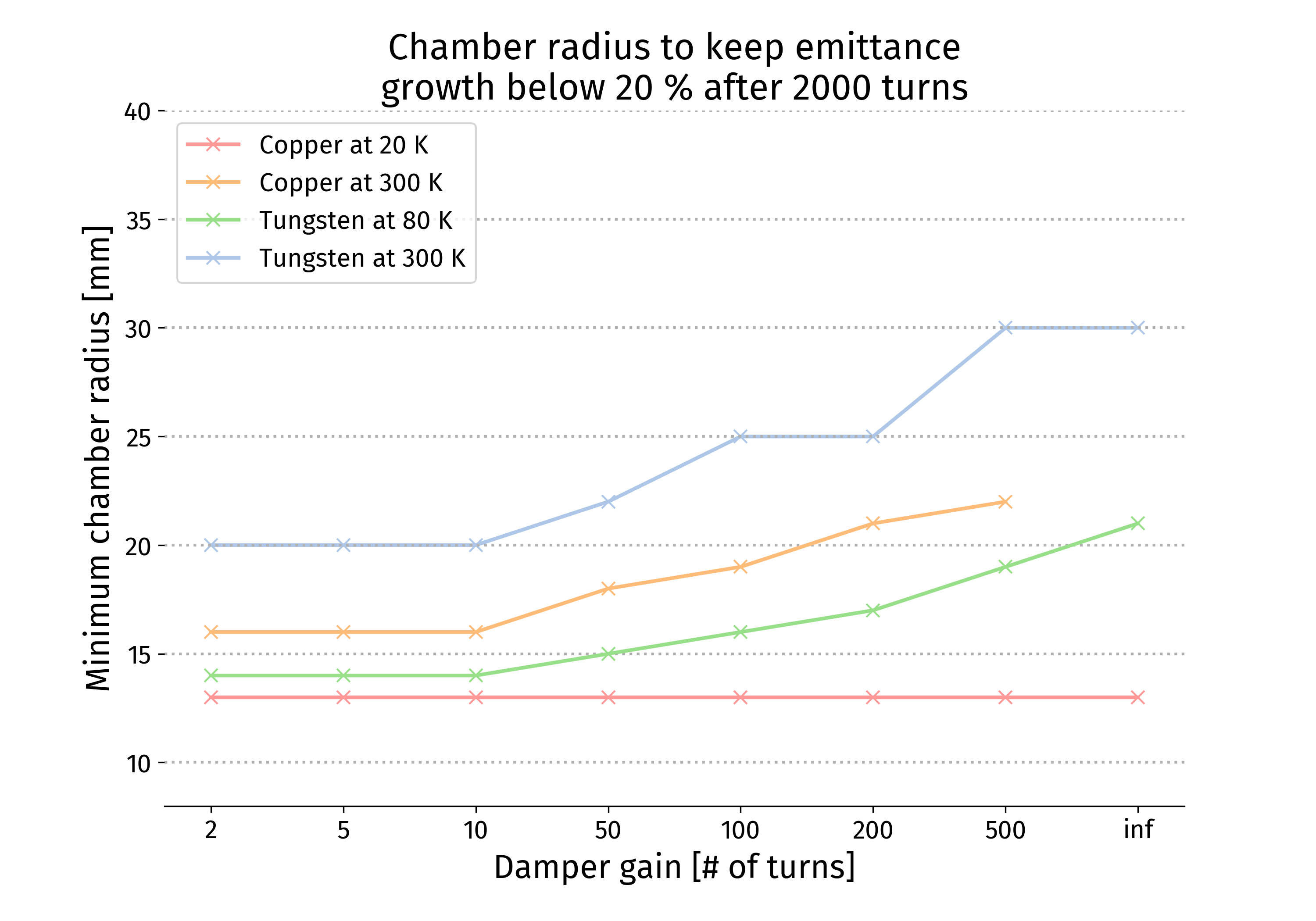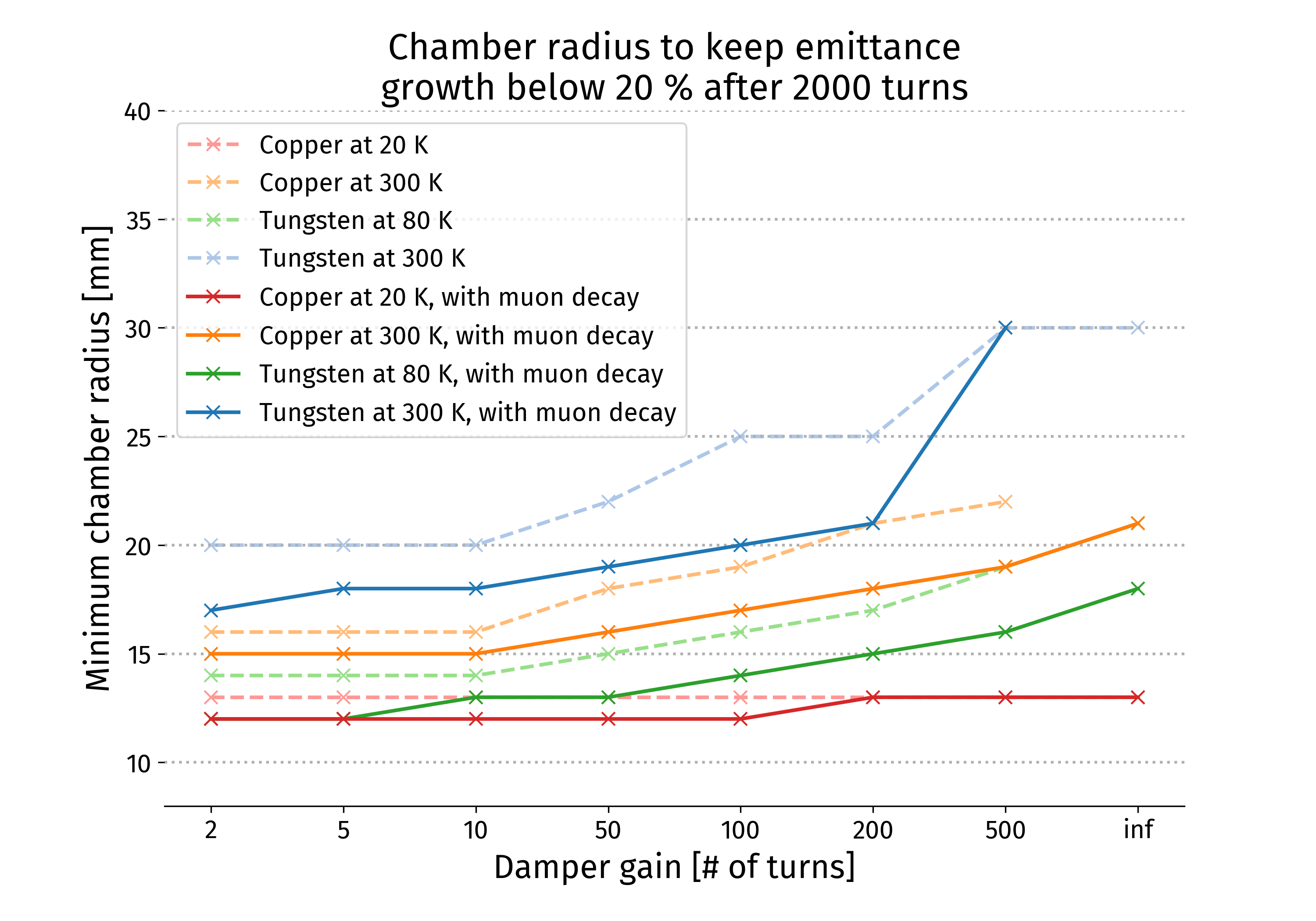General considerations for transverse beam stability #
These pages show the results of transverse beam stability simulations. Simulations are performed using the PyHEADTAIL macro-particle code.
Impact of material, chamber radius and transverse damper setting #
Simulation parameters #
We start form the impedance model scans. The main vacuum chamber parameters are recalled here:
| Item | Unit | Value |
|---|---|---|
| Machine | / | COLL3TEV |
| Total machine length | m | 4500 |
| Average beta function x/y | m | 100/100 |
| Chamber length | m | 4500 |
| Chamber geometry | / | Circular |
| Chamber inner radius | m | From 10 mm to 40 mm |
| Chamber material | / | Copper 300 K / Copper 20 K / Tungsten 300 K / Tungsten 80 K |
| Chamber thickness | m | Inf |
The detailled material properties and impedance model can be found in the other pages dedicated to the impedance model.
This stability study focuses on the impact of the vacuum chamber radius and material, and the transverse damper strength required to stabilize the beam. We assume the ring only contains one RF station, the transverse and longitudinal tracking are therefore performed for the full turn. An wake model was generated for each vacuum chamber along the impedance model. The wake and the kicks it generate are also lumped in one location per turn. Tracking is performed over 3000 turns at maximum.
The main beam parameters are detailled in the following table:
| Unit | Value | |
|---|---|---|
| Circumference | m | 4500 |
| Beam momentum | GeV/c | 1500 |
| Rev. frequency | kHz | 66 |
| RF frequency | MHz | 800 |
| Harmonic number | - | 12008 |
| RF voltage | MV | 250 |
| \(\alpha_p\) | - | -2.15e-6 |
| Aveg. beta x/y | m | 100/100 |
| Chromaticity x/y | - | 0/0 |
| Detuning from octupoles | m-1 | 0/0 |
| Synchrotron tune Qs | - | 0.000829 |
| Synchrotron period | turns | 1206 |
| Bunch length \(1 \sigma\) | mm | 5 |
| Bunch intensity | particles per bunch | \(2.2 \cdot 10^{12}\) |
| Transverse emittance x/y | \(\mu \mathrm{m\,rad}\) | 25 |
| Number of macroparticle | - | 5000 |
Summarized results #
The following plot shows the minimum chamber radius required to keep the transverse emittance growth below 20 % after 2000 turns, for different damper gains. Four material are considered: copper at 20 K (red), copper at 300 K (orange), tungsten at 80 K (green) and tungsten at 300 K (blue).

Impact of muon decay #
At 1500 GeV momentum, muons have a lifetime of 14285 * 2.2 us = 31.4 ms. The revolution frequency in the collider being ~66 kHz, muons have a lifetime of approximately 2100 turns in the 3 TeV collider. Therefore 50 % of the bunch intensity will be lost after ln(2) * 2100 turns = 1450 turns.
Simulation parameters #
Simulations including the muon decay effects have therefore been performed. A decay module was introduced in PyHEADTAIL (still to be published) that randomly removes particles turn after turn, according to the lifetime input.
The same stability simulations with chamber radius and material scan, and damper setting scan, were performed again. Parameters are identical to the previous simulations
Summarized results #
The following plot shows the minimum chamber radius required to keep the transverse emittance growth below 20 % after 2000 turns, for different damper gains. Four material are considered: copper at 20 K (red), copper at 300 K (orange), tungsten at 80 K (green) and tungsten at 300 K (blue). The muon decay effect is taken into account. In the plot, dashed lines show the results without muon decay.
